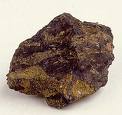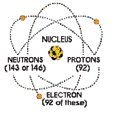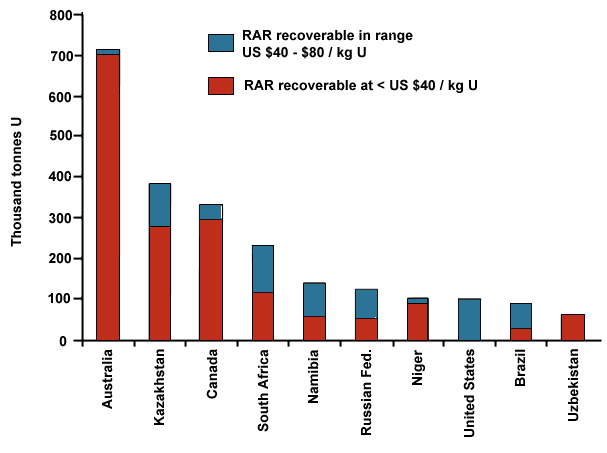|

Uranium Ore

A uranium atom
What is uranium?
Uranium is a naturally occurring element. It has a high density
and occurs naturally all over the world in sedimentary rock. Scientists think that uranium was formed in a supernova. That
makes it a nonrenewable resource for our accounts.
Where is uranium?
Uranium deposited in
the crust of the earth is mostly in sedimentary rock. When rock has enough uranium to make it economically valuable the rock
is considered uranium ore.
Examples of Uranium Concentrations:
|
High-grade ore - 2% U,
|
20,000 ppm U
|
|
Low-grade ore - 0.1% U,
|
1,000 ppm U
|
|
Granite
|
4 ppm U
|
|
Sedimentary rock
|
2 ppm U
|
|
Earth's continental crust (av)
|
2.8 ppm U
|
|
Seawater
|
0.003 ppm U
|
Due to the varied geology of the earth, this ore is not evenly distributed between countries.
Known Recoverable
Resources of Uranium:
|
--
|
Tonnes U
|
% of world
|
|
Australia
|
1,143,000
|
24%
|
|
Kazakhstan
|
816,000
|
17%
|
|
Canada
|
444,000
|
9%
|
|
USA
|
342,000
|
7%
|
|
South Africa
|
341,000
|
7%
|
|
Namibia
|
282,000
|
6%
|
|
Brazil
|
279,000
|
6%
|
|
Niger
|
225,000
|
5%
|
|
Russian Fed.
|
172,000
|
4%
|
|
Uzbekistan
|
116,000
|
2%
|
|
Ukraine
|
90,000
|
2%
|
|
Jordan
|
79,000
|
2%
|
|
India
|
67,000
|
1%
|
|
China
|
60,000
|
1%
|
|
Other
|
287,000
|
6%
|
|
World Content
|
4,743,000
|
-
|
Within the United States the largest concentrations of Uranium are in Wyoming, Texas, Colorado, New Mexico, and Utah.
Reasonably Assured Resources plus Inferred Resources:

|
|
But how long will these reserves last?
That is dependent on how quickly we use uranium. The
current usage is about 66,500 tU/yr. The world's present known and measured resources of uranium are about 4.7 MtU. Assuming
consistent consumption, no new further exploration and consistent demand based on prices this is enough to last for some 70
years.
But wait!
All estimates predict that demand will increase making more expensive energy
more economically feasible, new technology and advances in current technology will allow us to use uranium more efficiently
to create power and also mine more of it, and that further exploration will reveal more usable uranium.
* As oil and
natural gas become scarcer and more expensive demand for alternative fuels such as nuclear grow and make retrieving uranium
more economically feasible.
* The IAEA predicts that 10 million additional tons of uranium will be discovered. If this
is taken into account the 70 years now extend beyond 200.
* New mining and refining techniques and technology will expand
the amount of retrievable and usable uranium.
* If safety improves in breeder nuclear fission reactors, they could be
put into use. Breeder reactors use U-238 converted to Pu-239 and are highly efficient. U-238 is very plentiful naturally and
is a waste product of tradition nuclear fission. Breeder reactors could multiply the exploitation of uranium fifty times or
more, dramatically increasing the potential of nuclear energy.
|
 |
|
|

